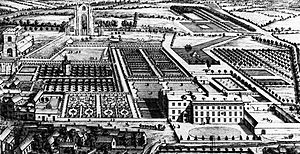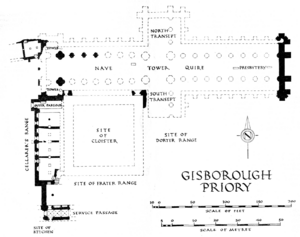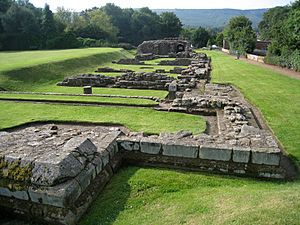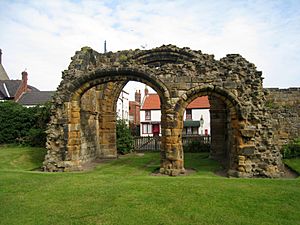Gisborough Priory facts for kids
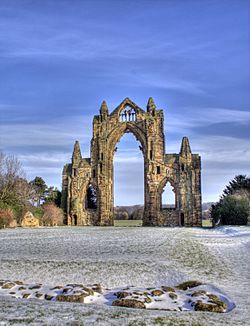
Gisborough Priory
|
|
| Monastery information | |
|---|---|
| Full name | Priory of St Mary of Gisborough |
| Order | Augustinian |
| Established | Around 1119 |
| Disestablished | 8 April 1540 |
| Dedicated to | God and the Holy Virgin Mary |
| Diocese | York |
| People | |
| Founder(s) | Robert de Brus |
| Site | |
| Location | Guisborough, Redcar and Cleveland, England |
| Coordinates | 54°32′10.56″N 1°2′53.03″W / 54.5362667°N 1.0480639°W |
| Visible remains | East window, west range, gatehouse, cellarium, dovecote |
| Public access | yes (English Heritage) |
Gisborough Priory is a ruined Augustinian priory in Guisborough, England. It was started in 1119 by Robert de Brus. He was an important Norman lord and an ancestor of the Scottish king, Robert the Bruce. The priory became one of the richest religious places in England. It received money and land from the king, nobles, and local people.
A big fire in 1289 destroyed much of the original priory. It was then rebuilt in the Gothic style, which was very grand. The remains you see today are some of the best examples of early Gothic architecture in England.
The priory did well until 1540. This is when King Henry VIII closed down all monasteries in England. The priory buildings were pulled down, and their stones were used for other buildings in Guisborough. The tall east window of the priory church was left standing. It became a famous landmark and a symbol for Guisborough.
The priory land became part of the Chaloner family's estate in 1550. They kept the east window because it looked beautiful next to their home, Gisborough Hall. Today, the priory is still owned by the Chaloners. However, English Heritage looks after it as a protected historical site.
Since the 1800s, people have dug up parts of the priory grounds to learn more about its past. You can still see the east window, parts of the west building, a vaulted cellar, a gatehouse, and a 14th-century dovecote (a building for pigeons). The Priory Gardens, created by the Chaloners, are also being restored. Both the ruins and gardens are open for everyone to visit.
Contents
History of Gisborough Priory
How the Priory Started
Guisborough was already an old town when the priory was built. Its name comes from a Scandinavian person called Gigr. The town was mentioned in the Domesday Book in 1086. After the Normans took over, William the Conqueror gave land in the area to Robert de Brus. He was one of the biggest landowners in the north of England.
At this time, there were not many monasteries north of the River Humber. This meant there were chances for new farms and religious places to grow. The Augustinian order came to England in the early 1100s. They built religious houses, including some big ones like Bridlington and Kirkham. Augustinians were canons (a type of priest) who lived by the rules of St. Augustine. They wore dark robes and were known as the "Black Canons."
Robert de Brus started the priory "to honour God, and the holy Virgin Mary." He gave the priory all of Guisborough, including land, churches, and mills. This gift was meant to provide everything the priory needed forever. Pope Calixtus II and Thurstan, the Archbishop of York, approved the priory's founding. The exact date is not clear, but it was likely around 1119.
Over the years, the priory gained more rights and money from royal gifts. King Henry III gave them the right to hold a market in Guisborough every Monday. He also allowed a three-day fair each year in August. The money from these events helped support the priory. The canons also had the right to hunt in the lands around Guisborough. Later, King Edward III allowed them to create a deer park. By the 13th and 14th centuries, the canons of Guisborough owned 4,000 sheep.
The priory was known for following the Augustinian rules very strictly. Its good reputation even attracted Saint Malachy from Ireland. The canons also worked closely with the Cistercians, another religious group focused on reform. As the priory became richer, some canons became less strict. The Archbishops of York had to step in to fix things.
Fire and Rebuilding
On May 16, 1289, a terrible fire hit the priory. A plumber working on the lead roof accidentally started the fire. The roof timbers caught fire, and melted lead poured into the church. Much of the building was destroyed, and many valuable items like books and chalices were lost.
The canons needed money to rebuild. They asked the king for help. The Archbishop of York and the Bishop of Durham also offered special blessings to people who donated. The de Brus family helped a lot with the rebuilding. Their family symbol was put on the new buildings.
Rebuilding took about 100 years. It was slow because of high costs and fighting in the early 1300s. Scottish raiders often attacked northern England, which lowered the priory's income. By 1380, the priory had only 26 canons and two lay brothers.
Even though the de Brus family line in Yorkshire ended, other noble families like the Fauconbergs and Thwengs continued to support the priory. Many important local nobles were buried there. Robert V de Brus, grandfather of King Robert the Bruce, was also buried there. In 1381, William, Lord Latimer gave money to finish the north part of the church and £333 for a new bell tower.
The Priory Closes Down

In 1533, King Henry VIII was removed from the church for divorcing his wife. In 1534, he declared himself the head of the Church of England. This meant the church's property in England now belonged to the king. A survey in 1535 found that Gisborough Priory was very wealthy. It was the fourth richest monastery in Yorkshire.
In 1536, smaller monasteries were closed. Gisborough Priory was safe at first because it was so rich. But a second survey led to its final closure. The leader of the priory, James Cockerell, was forced to leave. He was replaced by Robert Pursglove, who was loyal to the king.
Local people were not happy about the priory closing. About 500 families depended on it for their jobs. There was even a protest called the Pilgrimage of Grace. Prior Cockerell was involved in this protest and was later punished.
The priory officially closed on April 8, 1540. It was one of the last monasteries in England to be shut down. Most of the priory buildings were pulled down. The stones were used for other buildings. The central tower was collapsed into the church, turning it into rubble.
The land was later sold to Sir Thomas Chaloner in 1550. The Chaloner family lived in parts of the old priory before building a new house. The fallen stones were taken or sold. A local historian in the 1800s, John Walker Ord, wrote sadly about how priory stones were used in many buildings around Guisborough. He saw beautiful carved stones used for things like gateposts and pig houses.
Some parts of the priory even traveled further. At Hardwick Hall, a fake ruin was built using stones from Gisborough Priory. Local stories say the priory was so rich that an underground tunnel led to a cave with a chest of gold, guarded by a raven.
The Chaloner family made a lot of money from the priory lands. Around 1595, Sir Thomas Chaloner's son, also named Thomas, started England's first alum works nearby. Alum was important for fixing dyes on cloth. Chaloner supposedly learned how to make alum by visiting Italy and seeing similar soil near Rome. He then brought workers from Rome to Guisborough, which made the Pope very angry!
The only large part of the priory that survived was the eastern wall with its great east window. This was thanks to a new interest in Romanticism in the 1700s. People started to appreciate ruined buildings for their beauty. Artists like J. M. W. Turner painted them. The Chaloner family kept the east window as a beautiful ruin in their gardens. Turner himself sketched it in 1801.
The area in front of the east window was used for big events. A special ditch called a ha-ha was built to keep cattle out. To the south, a long path called the Long Terrace led to the ruins. Steps with carved sea-wolves (which locals thought were dragons) led up to it.
Old Gisborough Hall was pulled down around 1825. The Chaloners built a new mansion, Gisborough Hall, in 1857. In 1932, the priory was given to the Office of Works, which is now English Heritage. English Heritage maintains the ruins, and the local council manages daily visits.
Local stories say the priory is haunted by a monk in a black robe. He supposedly returns every year on the first new moon to check on buried treasure. In the 1960s, people gathered to watch and some claimed to see a hooded figure.
What the Priory Looks Like Today
Gisborough Priory has a few very clear remains. The most striking is the tall east wall of the priory church. You can also see the bases of some columns and excavated graves. The outline of the cloister (a covered walkway) is visible, but most of it is still underground. The ruins of the west building are the largest parts still standing above ground. A ruined gatehouse and a dovecote (a pigeon house) are also on the site.
The Priory Church
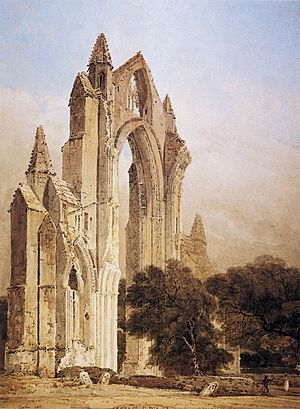
The eastern wall of the church is the most impressive part. Its great east window is considered one of the best examples of church architecture from the late 1200s. It looks very similar to the design of Ripon Cathedral. The window once had seven main openings for glass. In the middle was a large circle with smaller openings shaped like three-leaf clovers.
The main east wall has huge buttresses (supports) with pointed tops. Similar pointed tops are on the main gable, next to a small window. A bracket once held a statue, probably of the Virgin Mary, to whom the priory was dedicated.
Not much else of the church stands tall, but we can learn a lot from the stones. The church was about 107 meters (351 feet) long. The roof was about 29.6 meters (97 feet) high. The main arches were supported by columns with carved leaves. The upper windows and gallery were combined into one large arch. The ceiling was made of stone with carved decorations, some of which still had traces of red, white, and gold paint.
Spiral staircases on each side of the east wall allowed people to reach all parts of the building for maintenance. Nothing remains of the north or south arms of the church, which extended into the graveyard of St Nicholas's Church.
Several important people were buried inside the priory. In the 1800s, archaeologists found stone coffins. Two grave slabs are visible below the east window. The priory also had a special memorial to its founders, the Brus family. This memorial was taken apart in 1540 but was put back together in the 1800s. It is now in St Nicholas' Church next to the ruins.
The priory church also had a shrine to the Virgin Mary. It was one of the most important Marian shrines in northern England. It was destroyed when the priory closed. However, it was restarted in 1949 and is now in St Paulinus Church in Guisborough.
Other Priory Buildings
You can see parts of other priory buildings. To the south of the church was a cloister, a square courtyard with covered walkways. It was about 36.5 meters (120 feet) square. This cloister replaced an earlier one destroyed in the 1289 fire. In 1854, some arches and columns from the cloister were taken to London for an exhibition.
Parts of the west building, called the cellarer's range, still exist. This building had an outer room where visitors were received. The prior (the head of the priory) lived on the upper floor. The largest surviving part of this building is a cellarium, or storehouse. It is a vaulted cellar made of stone, built below the level of the cloister. It is quite well-preserved.
Most of the dining hall (refectory) and dormitory buildings are still underground. Only the western end of the dining hall has been dug up. It also has a vaulted cellar.
Outer Buildings
The priory buildings were inside a walled area with two courtyards. There were gatehouses at the entrances. Only the remains of the main gate of the inner courtyard are still standing. This gate had an outer porch, an inner gatehall, and a porter's lodge. The outer porch has a large arch for wagons and a smaller arch for people.
The canons also built an octagonal dovecote (pigeon house) nearby. It was built in the 1300s and changed in the 1700s with a new roof. It is still used today as a garden store, but visitors cannot go inside.
Older Buildings on the Site
Gisborough Priory was rebuilt three times. The ruins you see today are mostly from the third rebuilding. Before the priory, there was an Anglo-Saxon settlement here. People have found old pottery and an 8th-century coin under the priory ruins.
The first Norman priory was built around 1180. It was short and narrow, with two aisles and a single tower. It had doors for both the canons and local people. Many graves were found from this first priory.
Around 1200, the priory was rebuilt on a larger scale. The old church was pulled down to its first layer of stones. This new church had twin towers at the west end and a large round window. It also had piped water. The floors were covered with colorful tiles. The north aisle had small private chapels where local nobles were buried. An unusual feature was a well dug into the church floor, possibly to ensure water supply.
The fire of 1289 left scorched paving stones. While it was thought the church was completely rebuilt, excavations show that parts of the less damaged west end were reused. This meant the two ends of the church were built in different styles. The rebuilding was a huge job and took many years.
Priory Gardens and Monks' Pond
The Chaloner family created formal gardens south of the priory. In the early 1700s, they planted the Monks' Walk, a double row of trees. Old stones found during excavations were placed here. This area was used for music and plays. The Monks' Walk is now being restored by a volunteer group.
In the late 1800s, Margaret Chaloner, the first Lady Gisborough, designed more formal gardens. These had fancy flower beds and gravel paths. There was a rose garden and a sunken Italian garden with a pool. These gardens are now free to visit.
Further east is the Monks' Pond, where the canons kept fish. It offers a beautiful view where the priory arch is reflected in the water. In 1908, Lady Gisborough held a water show here to raise money for St Nicholas' Church. The pond used to have very large fish, but pollution in 2000 caused many fish to die.
Excavations at the Priory
Between 1865 and 1867, Captain Thomas Chaloner and William Downing Bruce did the first big dig at the priory. They found a stone coffin with a tall man's skeleton, parts of a memorial, and painted roof decorations. They also found evidence of the 1289 fire, like melted metal stuck to the floor.
In 1932, the Office of Works dug more to make the site safe for visitors. More work was done in the 1940s and 1950s, uncovering more of the priory.
In 1985–86, a major dig happened at the west end of the church. This was because an old burial vault had collapsed. The dig found more signs of the 1289 fire, including burned stones and a broken bell. They also found the remains of 47 people, including men, women, and children. Some had items buried with them, like a gold ring and jet crosses. Two chalices and patens (plates for communion bread) were found with two priests. The skeletons were later cremated and their ashes scattered in the Monks' Walk. Surveys of the ground show that more monastic buildings are still buried and waiting to be dug up.
Priors of Gisborough Priory
Here are the names of the leaders (Priors) of Gisborough Priory and when they were in charge:
- William de Brus (1119–45?)
- Cuthbert (1146–54)
- Ralph (1174?–80)
- Roald (1199–?)
- Lawrence (1211–12)
- Michael (1218–34)
- John (1239–51, 1257)
- Simon (date uncertain)
- Ralph de Irton (1262)
- Adam de Newland (1280)
- William de Middleburgh (1281)
- Robert de Wilton (1320–1)
- John de Darlington (1346)
- John de Horeworth or Hurworth (1364–93)
- Walter de Thorp (1393)
- John de Helmesley (1408)
- John Thweng (1425)
- Richard Ayreton (1437)
- Richard de Hoton (1452)
- Thomas Darlington (1455)
- John Moreby (1475)
- John Whitby (1491–1505)
- John Moreby (1505)
- William Spires (1511)
- James Cockerill (1519–1534?)
- Robert Pursglove (1537, 1539)
Other Burials at the Priory
Many important people were buried at Gisborough Priory, including:
- William Neville, 1st Earl of Kent
- John Lumley, 4th Baron Lumley
- William de Brus, 3rd Lord of Annandale
- Robert de Brus, 4th Lord of Annandale
- Isabella of Gloucester and Hertford
- Robert de Brus, 5th Lord of Annandale
- William Latimer, 4th Baron Latimer
Images for kids
-
Prior Robert Pursglove, the last leader of Gisborough Priory
-
The ruins of Gisborough Priory in 1801, painted by Thomas Girtin.
See also
 In Spanish: Priorato de Gisborough para niños
In Spanish: Priorato de Gisborough para niños



